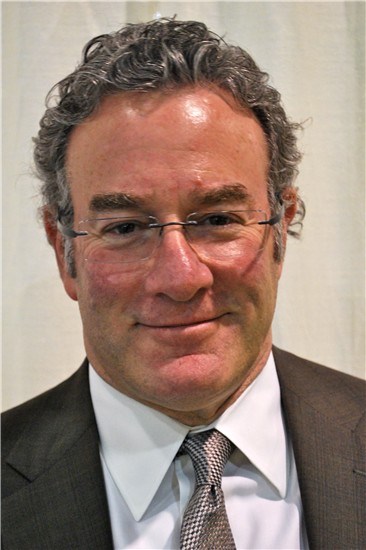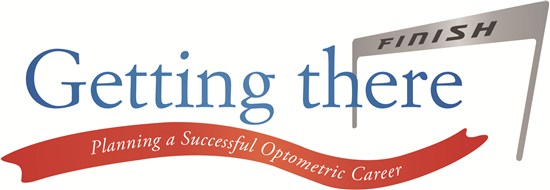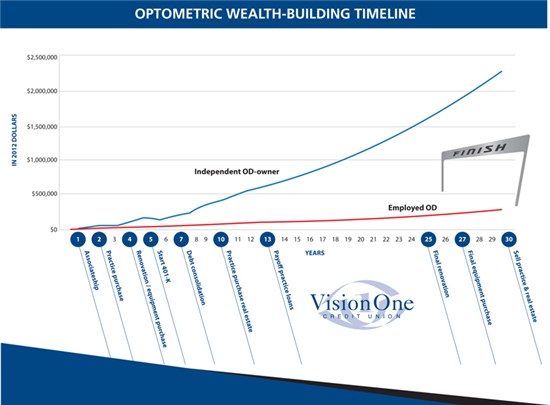By Robert Schultz
 Success in practice has many definitions. First, you and your staff must provide the highest level of care to patients. Second, you must manage and grow your practice to be viable in a challenging marketplace. Ultimately, though, a successful practice must provide you with an asset that, at the close of your optometric career, can sustain you in retirement.
Success in practice has many definitions. First, you and your staff must provide the highest level of care to patients. Second, you must manage and grow your practice to be viable in a challenging marketplace. Ultimately, though, a successful practice must provide you with an asset that, at the close of your optometric career, can sustain you in retirement.
This is the first in a series of articles about how to plan for long-term practice success, and how to implement a value-building strategy to ensure that you…get there.
Starting Out…With the Finish Line in Sight
An optometric career, at its start, is about capturing opportunities to learn and earn. You must develop and apply clinical and management skills and increase revenues. At the same time, you must pay down student loans and meet practice acquisition debt service, while satisfying personal and family living needs.
But what is the measure of a successful optometric career, in total? To begin to answer that question, ask: Am I creating something of value that will sustain me at the close of my career? Further, will the practice I envision meet my personal life goals?
Accordingly, an optometric career should begin with a focus not just on the starting line but on the finish line, as well. In fact, no matter where you are in the course of your optometric career, you need to keep that finish line in sight, to ensure that you get there.
Conceptualize: What kind of a practice do you want to own and run–and how does that practice help me to meet my life goals? Visualize a family-based practice and a specialty practice, a practice locatedin a mall and one in a medical building. Envision practices with revenues of $500,000, $1 million, $1.5 million-plus. Think of how you want to work–and how you want to manage associates or partners who are essential elements in achieving those revenue levels. Think also of thenumber of staffthat are required to support those levels of revenues. Identify why each type of practice appeals to you or not. Ask yourself what it would take to own, build and run such a practice—both in financial resources and in personal time and effort.
Strategize: What is your strategic plan to own/build/run such a practice? How much would it cost to finance the acquisition? In how many years do you want to pay off your acquisition loan? Are you planning to have the acquisition loan paid off when you need to borrow more to renovate, expand or acquire a second location to ensure that you are continuing to build value in your practice?
Extrapolate: Once you identify your ideal practice, take the value (sale price) and compare it to the size of the retirement fund you need to cover the cost of retirement today at your desired income level over a 20-25 year retirement. Key elements: housing, living costs, travel, medical,lifestyle needs. Could you live well if you sold your ideal practice today?

Compute: Now estimate: What will your ideal practice be worth in 20-30 years? The critical question: Can that amount provide for your retirement in 20-30 years? If not, what are ways to reconfigure your plans to meet your goal? Just how much will you need to retire—when you need to retire?
Contemplate: What does retirement look like with $2 million in assets? With $2.5 million in assets? Or with $5 million, adjusted for inflation? Consider where you want to live and in what sort of housing and community, with mobility and lifestyle activities.
Research: Consider using the services of a financial planner to help you to achieve your goal. A financial planner can set up retirement targets. For example, if you now earn $180k per year and determine that you will need $150k per year to live well in retirement for 20-25 years, what quantity and quality of assets do you need to amass—and in how many years? A planner can readily identify a shortfall, and along with a practice consultant can suggest strategies to bridge the gap in the time you have left before retirement.
Optometric Wealth-Building Timeline: Steps to Success
The following wealth-building timeline shows the steps that are taken(and when) ina typical route toward a retirement goal of $2 million-plus in assets, amassed over 30 years of optometricpractice ownership. Individual results vary.
Related ROB Articles
Practice Transition Team Checklist: Get the Right People on Board
Six Strategies to Take Your Practice to the Next Level
Grow or Die: Complacency is a Practice Killer
Robert Schultz is president and CEO of Vision One Credit Union in Sacramento, Calif. To contact him or to learn more about financial resources from Vision One Credit Union: BSchultz@visionone.org.



























